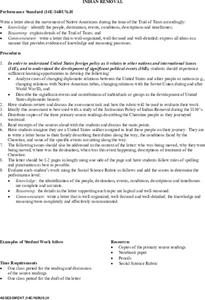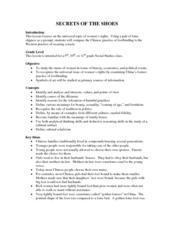Curated OER
Preserving the Past with Oral History
Pupils engage in oral history learning by conducting interviews and recording them to documents for the local community.
Curated OER
Preserving the Past with Oral History
Young scholars research history by interviewing people in their community. They create a list of questions and record their responses. They end the project with some type of final product which might include a memory book.
Curated OER
Heritage and Citizenship: Traditions, Celebrations and Cultural Diversity
Second graders explore the concept of cultural diversity. In this traditions lesson, 2nd graders investigate the cultures of Canada as they discuss traditions within the country. An extension mathematics activity is included.
Curated OER
Indianapolis Government
Students read about a girl who takes a trip during the time of the State Capital moving to Indianapolis and then write their own essay about a trip that they took. In this Indianapolis Government lesson plan, students use maps and...
Curated OER
Push/Pull factors in Immigration
Students explore the push/pull factors experienced by immigrant families. They interview a parent and an American about their family's immigration history. Students write a summary of the interview and compare the push/pull factors of...
Curated OER
A Day at the Market
Students describe role of market place in 18th-century Virginia, explain how trade and economy were part of young person's educational process,
take part in the classroom marketplace, and compare shopping in colonial times and as part...
Curated OER
Exploring Cultural Rituals
Learners analyze images and music of common rituals in America with those of other countries. They use worksheets to compare and contrast the events.
Curated OER
Greek culture and Aesop's Fables
Tenth graders explain political and social thought during the Greek 6th and 5th centuries B.C. They research five to eight fables, figuring out the moral for each and writing an essay on how Aesop influenced the morals and ideals of...
Curated OER
Pictures of the Past
Students explore how women's roles in society have changed over time. They create a personal timeline using photographs and pertinent dates and complete a reflection paper sharing their views on the roles of women in society past and...
Curated OER
Sending Messages, Then and Now
Students analyze how patriots created ways to communicate during the Revolutionary War. After reading about and discussing ways patriots communicated, students create a chart analyzing the way messages are sent today with the way...
Curated OER
Petition of Amelia Bloomer Regarding Suffrage in the West
Students investigate the role of Amelia Jenks Bloomer in the struggles for suffrage and political reform. They consider the factors involved in political socialization and compile webliographies of their research materials.
Curated OER
Indian Removal
Students investigate the historical events surrounding The Trail of Tears. They write a letter that identifies the people, destination, events, and descriptions surrounding the timeframe. Students provide a written summary of the history...
Curated OER
Uncle Tom's Cabin
Students read the novel, Uncle Tom's Cabin, and explain public attitudes towards slavery in 19th century America.
Curated OER
Class in the Media: Writing a Television Show
Students look at popular media presentations to determine what type of messages they convey about class and class-linked behavior. They listen to contemporary music to explore how the songs touch upon social class issues. They read...
Curated OER
Secrets of the Shoes
Students compare the Chinese practice of footbinding to the Western practice of wearing corsets to discover universal issues involving women's rights. The instructional activity emphasizes small group discussions.
Curated OER
The Immigrant Experience
Students utilize oral histories to discover, analyze, and interpret immigration and migration in the history of the United States. A goal of the unit is fostering a discussion and encouraging students to make meaning of the bigger...
Curated OER
No Joke - My Voice Counts!
Students respond to cartoons. In this social and cultural issues lesson, students examine how cartoons can be used to get a message across to the reader. After examining numerous cartoons, students create their own cartoon with a social...
Curated OER
Discovering Our Legacy of Giving
Seventh graders examine the characteristics of philanthropists. In this cross- curricular lesson, 7th graders evaluate the character traits of people from a film. Students write a metaphor about responsibility to community.
Curated OER
Jim Thorpe: The Greatest Athlete of the Century
Students discuss what makes a sports legend. In this Jim Thorpe activity students analyze both the triumphs and tragedies of Jim Thorpe's sports career. Students then write a letter persuading their representative to name Jim Thorpe the...
Curated OER
Slavery Lesson
Fourth graders explore the issue of slavery. In this African American history lesson, 4th graders visit a website to take a virtual journey on the Underground Railroad. Additionally, students read various suggested slave narratives....
Curated OER
Micro-finance Challenge
Students play a micro-finance game. in this global economy instructional activity, students play a game that assists them in concepts of micro-finance. Students will also watch a business development video and explore additional resources.
Curated OER
How Historians Know: Investigating a Midwife's Life
Students view "A Midwife's Tale" to explain the methods historians use to study the past. They complete worksheets to identify what historians look for.
Curated OER
Migrating to Texas
Fourth graders explore the migration to Texas from other parts of the United States. Through journal entries they write about the trip as if they were the settlers coming to a new and foreign country. Working in small groups, 4th graders...
Curated OER
Creation of An Educational Toy, Game, or Story
Seventh graders create a toy, game or story suitable for a young child. They research magazines, catalogs, and child development texts for ideas. Students consider the age and development of the child.

























